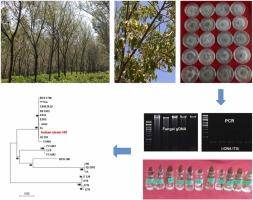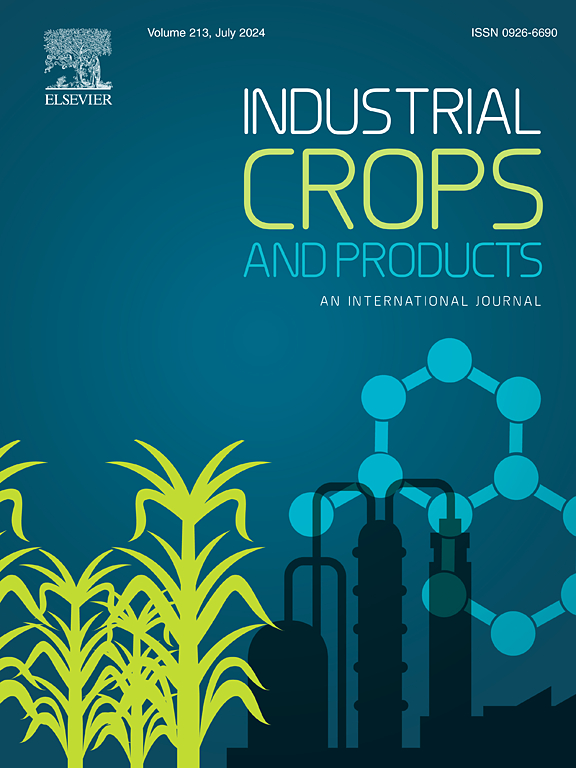南印度橡胶园仙后座菌菌落菌素谱的多样性及培养滤液毒性
IF 5.6
1区 农林科学
Q1 AGRICULTURAL ENGINEERING
引用次数: 0
摘要
摘要本研究旨在确定cassiicola (Corynespora cassiicola (Berk.))的cassiicolin谱(存在/缺失和序列多态性)。,Curt)。魏。巴西橡胶树(野生)Corynespora leaf fall disease (CLFD)的病原。例:A. Juss。Muell。参数。以及它们的培养滤液对印度的易感和耐受性橡胶品种的毒性。聚合酶链反应与引物针对各种cassiicolin基因产生一个扩增子仅在一个分离(30)。这个扩增子后来被测序证实是cas2基因。其余分离株均归为cas0(无cassiicolin基因)。从印度分离出的cas2基因与巴西和中国分离出的cas2基因相同或密切相关。对3个橡胶品种叶片的培养滤液毒性分析表明,包括含Cas 2的分离株在内的3个分离株对不同品种均有较强的萎蔫作用。其他菌株对GT 1和RRII 105的毒性程度不同,而品种FX 516的毒性大多不敏感。通过菌丝塞控制接种,证实了三株具有滤液毒性的分离株的毒力。从印度橡胶林中分离出的cassiicola HV与中国和巴西的cas2分离株具有密切的系统发育关系。cassiicolin同型cas2与毒力之间的联系尚不清楚,但cas0和cas2分离株在同一品种上显示出相似的滤液毒性,这一事实表明,除cassiicolin外的其他毒性因素仍有待发现。本文章由计算机程序翻译,如有差异,请以英文原文为准。

Diversity of cassiicolin profiles and culture filtrate toxicity of Corynespora cassiicola isolates from South Indian rubber plantations
This study aimed to determine the cassiicolin profile (presence/absence and sequence polymorphism) of Corynespora cassiicola (Berk. & Curt.) Wei., the causative agent of Corynespora leaf fall disease (CLFD) in Hevea brasiliensis (Willd. ex A. Juss.) Muell. Arg. and the toxicity of their culture filtrates towards both susceptible and tolerant rubber varieties in India. Polymerase Chain Reaction with primer targeting the various cassiicolin genes produced a single amplicon in one isolate only (out of 30). This amplicon was later confirmed by sequencing to be the Cas 2 gene. All other isolates were classified as Cas 0 (without cassiicolin gene). The Cas 2 gene detected from the Indian C. cassiicola isolate (HV) was found identical or closely related to the Cas 2 genes from Brazilian and Chinese C. cassiicola isolates. Analysis of the culture filtrates toxicity on leaves from three rubber cultivars revealed that three isolates, including the Cas 2-containing isolate, induced a strong wilting effect whatever the cultivar. For the other isolates, various levels of toxicity were measured on GT 1 and RRII 105, while the cultivar FX 516 was mostly insensitive. Virulence of the three isolates showing filtrate toxicity was confirmed by controlled inoculation with mycelium plugs, on all three rubber cultivars. C. cassiicola isolate HV, obtained from a heavily Corynespora leaf fall disease-infected rubber plantation in India, exhibits a close phylogenetic relationship of Cas 2-containing isolates with those from China and Brazil. The link between cassiicolin isoform Cas 2 and the virulence is still unknown, but the fact that both Cas 0 and Cas 2 isolates show similar levels of filtrate toxicity on the same cultivars indicates that toxic factors other than cassiicolin remain to be discovered.
求助全文
通过发布文献求助,成功后即可免费获取论文全文。
去求助
来源期刊

Industrial Crops and Products
农林科学-农业工程
CiteScore
9.50
自引率
8.50%
发文量
1518
审稿时长
43 days
期刊介绍:
Industrial Crops and Products is an International Journal publishing academic and industrial research on industrial (defined as non-food/non-feed) crops and products. Papers concern both crop-oriented and bio-based materials from crops-oriented research, and should be of interest to an international audience, hypothesis driven, and where comparisons are made statistics performed.
 求助内容:
求助内容: 应助结果提醒方式:
应助结果提醒方式:


